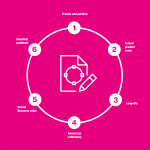Total Quality Management (TQM) is a structured system for satisfying internal and external customers and suppliers by integrating the business environment, continuous improvement, and breakthroughs with development, improvement, and maintenance cycles while changing organizational culture. TQM aims for quality principles to be applied broadly throughout an organization or set of business processes. Total Quality Management (TQM) programs focus on improvement in individual operations with unrelated processes; as a consequence, it takes many years before all operations within a given process are improved. Six Sigma focuses on making improvements in all operations within a process that produce results more rapidly and effectively.
The Six Sigma’s Breakthrough Strategy is a disciplined method of using extremely rigorous data-gathering and statistical analysis to pinpoint sources of errors and ways of eliminating them. Six Sigma relies on the voice of the consumer to set the standard of acceptable performance. Six Sigma has a systematic approach to both validate data and to focus on the critical few inputs that will have the greatest potential to effect meaningful improvement.
Six Sigma focuses on reducing defects in management and clinical process; it uses statistical analysis to find the most defective part of the process, and rigorous control procedures to sustain improvement.
While Six Sigma is a long-term strategy, it is designed to generate immediate improvements to profit margins too. Compared to traditional quality management programs such as TQM that project three or more years into the future, Six Sigma focuses on achieving financial targets in twelve-month increments.
TQM and Six Sigma have a number of similarities including the following:
1. A customer orientation and focus
2. A process view of work
3. A continuous improvement mindset
4. A goal of improving all aspects and functions of the organizations
5. Data based decision-making
6. Benefits depend highly on effective implementation
A key difference between TQM and Six Sigma is that Six Sigma focuses on prioritizing and solving specific problems which are selected based on the strategic priorities of the company and the problems which are causing the most defects whereas TQM employs a more broad based application of quality measures to all of the company’s business processes. Another difference is that TQM tends to apply quality initiatives within specific departments whereas Six Sigma is cross-functional meaning that in penetrates every department, which is involved in a particular business process that is subject to a Six Sigma project.
Another difference TQM provides less methodology in terms of the deployment process whereas Six Sigma’s DMAIC framework provides a stronger platform for deployment and execution. For example, Six Sigma has a much stronger focus on measurement and statistics, which helps the company, define and achieve specific objectives. Six Sigma is complementary to TQM because it can help to prioritize issues within a broader TQM program and provides the DMAIC framework, which can be used to meet TQM objectives.
Conclusion
Both measurements of quality control within an organization have brought true success to companies who have applied their policies and procedures.
The leaders and management teams of any organization will have to evaluate which quality of control tactic is the most beneficial to the growth and improvements of their business.
The one way to analyze your business is to establish your goals and vision for your organization and set plans in place to evaluate if Six Sigma or Total Quality Management falls in the realms of what you are seeking.
Both processes have taken the best of the best countries and companies from good to great and I personally feel that as long as you have one of these processes in place, you are setting yourself up for success.
.

101,413 Comments
https://tempo.com.ph/2015/05/07/ama-faces-acid-test-vs-jumbo
Every weekend i used to visit this web page, because i want enjoyment, as this this web site conations truly nice funny material too.
Hmm it appears like your blog ate my first comment (it was super long) so I guess I’ll just sum it up
what I had written and say, I’m thoroughly enjoying your
blog. I too am an aspiring blog blogger but I’m still new to the whole thing.
Do you have any suggestions for newbie blog writers? I’d really appreciate it.
generic valtrex
For the reason that the admin of this web site is working, no hesitation very soon it will be renowned, due to its feature
contents.
I’m no longer certain where you are getting your information, but good topic.
I must spend some time learning more or understanding more.
Thanks for great info I used to be in search of this information for my mission.
If some one desires expert view concerning blogging after that i advise him/her to go to
see this webpage, Keep up the nice work.
Hi there to every single one, it’s really a good for me to visit this website, it includes priceless Information.
Just desire to say your article is as astounding.
The clarity on your put up is simply cool and that i could suppose you’re
an expert in this subject. Well with your permission let me to seize your feed to keep updated with imminent post.
Thanks one million and please continue the enjoyable work.
Thanks for ones marvelous posting! I certainly enjoyed reading
it, you can be a great author. I will ensure that I bookmark your blog and will eventually
come back at some point. I want to encourage you
to definitely continue your great job, have a nice evening!
excellent publish, very informative. I ponder why the opposite experts
of this sector do not understand this. You should proceed your writing.
I am sure, you have a great readers’ base already!
Link exchange is nothing else however it is just placing the other person’s blog link on your
page at appropriate place and other person will also do same for you.